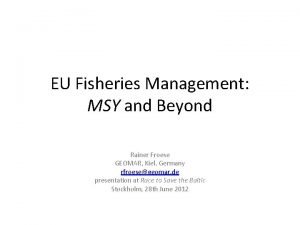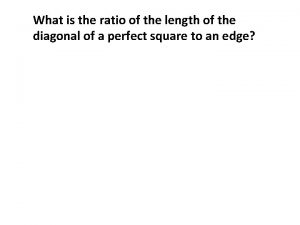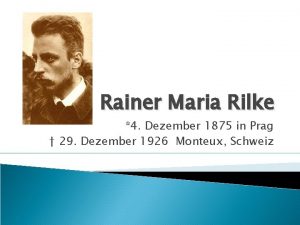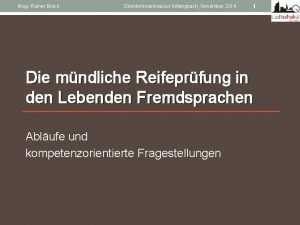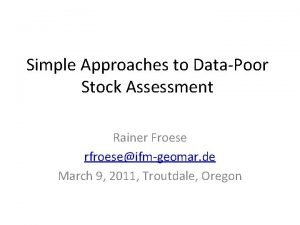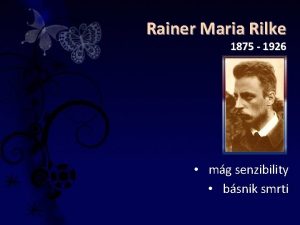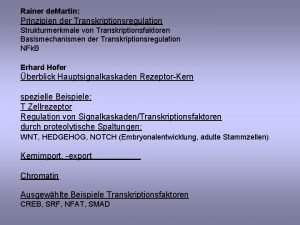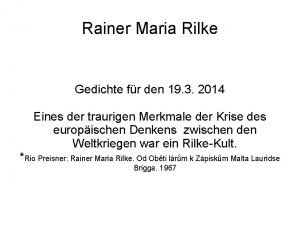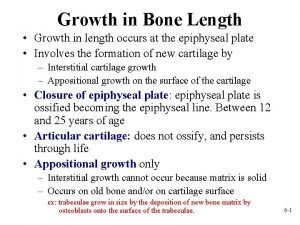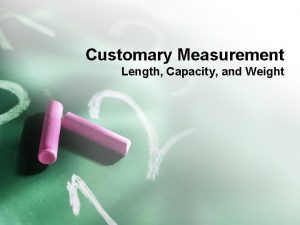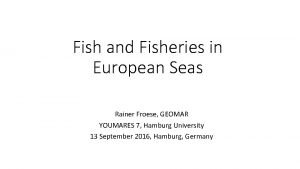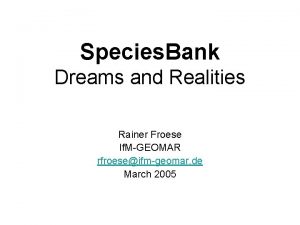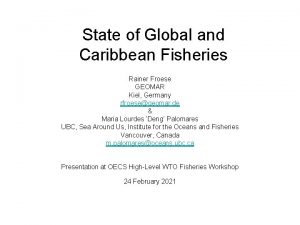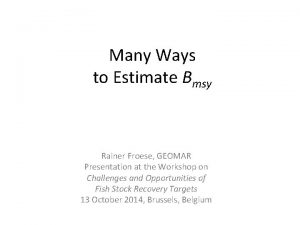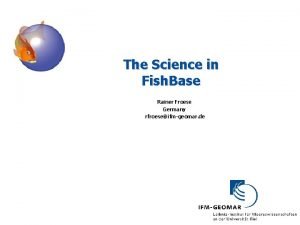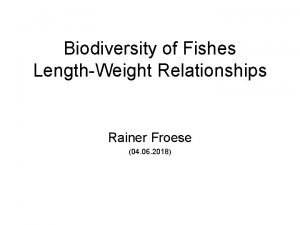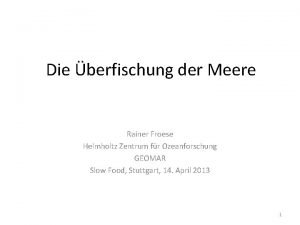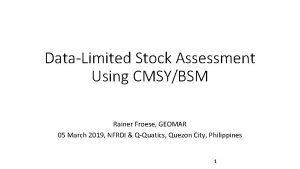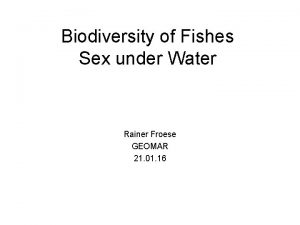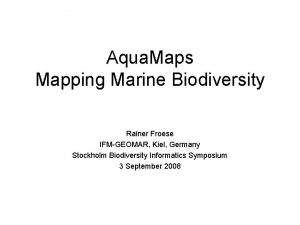Growth in Length and Weight Rainer Froese SS





























- Slides: 29

Growth in Length and Weight Rainer Froese SS 2008

Why is Growth Important? • Determines increase in body mass • Determines maturation and generation time • Determines population increase • Determines sustainable yield

Fish Grow Forever

von Bertalanffy Growth Von Bertalanffy’s (1934) Growth Function (VBGF) d. W/dt = H * W 2/3 – B * W where W=weight, H ~ metabolism, B ~ catabolism Solving the differential equation results in Wt = Winf (1 – e-K * t)3 Lt = Linf(1 - e-K * t)

Using VBGF Lt = Linf (1 – exp(-K * (t – t 0))) Where Lt = length (cm) at age t (years) Linf = asymptotic length if t = infinite K = parameter indicating how fast Linf is approached (1/year) t 0 = hypothetical age at L = 0

Using VBGF Wt = Winf (1 – exp(-K * (t – t 0)))b Where Wt = weight (g) at age t (years) Winf = asymptotic weight if t = infinite b is the exponent of the length-weight relationship W = a. Lb K and t 0 same as with VBGF for length

Age at Length • In species with indeterminate growth there is a unique relationship between age and length, and vice versa: t. L = -LN(1 – L / Linf) / K + t 0

Understanding K K describes the steepness of the growth curve, i. e. , how fast Linf is reached: K <= 0. 05 in large, long-lived fishes K > 1 in small, short-lived fishes

Understanding Linf is similar to maximum size (e. g. mean of three largest specimens) reached in an unfished population Linf = Lmax / 0. 95 = Lmax + 0. 05 Lmax

Linf as a Function of Lmax log 10 L = 0. 044 + 0. 9841 * log 10(Lmax) (n = 551, r 2 = 0. 959) Froese, R. and C. Binohlan 2000. Empirical relationships to estimate asymptotic length, length at first maturity and length at maximum yield per recruit in fishes, with a simple method to evaluate length frequency data. J. Fish Biol. 56: 758 -773.

Understanding t 0 • Length at birth t=0 is larger than zero • t 0 is used to correct for that and improve the fit of the curve by moving it to the left • t 0 is thus the hypothetical age at L=0 if VBGF would apply to larvae • t 0 does not change K or Linf • Growth curves without t 0 give length at ‘relative’ age

Growth and Maturity • VBGF in weight has an inflection point at 0. 296 Winf ~ 2/3 Linf = Lopt

Fish Grow Forever

Growth and Maturity • VBGF in weight has an inflection point at 0. 296 Winf ~ 2/3 Linf = Lopt • At Lopt production of tissue and gonads is fastest • Semelparous fish mature at Lopt • Iteroparous fish mature so that Lopt is reached within the average duration of the reproductive phase, typically between 1/3 and ½ Linf

Length at Maturity vs Linf Log 10 Lm = 0. 8979 * log 10 Linf -0. 0782 r 2= 0. 888 n=467 Relationship between length at first maturity and asymptotic length for all records representing 265 species of fish. Regression lines are for females (----) and males ( ). Froese, R. and C. Binohlan 2000. Empirical relationships to estimate asymptotic length, length at first maturity and length at maximum yield per recruit in fishes, with a simple method to evaluate length frequency data. J. Fish Biol. 56: 758 -773.

Grow Fast, Die Young

Interrelationship between K and Linf are inversely correlated -> Fish. Base, Micropterus salmoides, Growth, Auximetric graph K is NOT a growth-per-time indicator: Anchovy K >1. 0 reach 20 cm in second year Cod K ~ 0. 13 reaches 30 cm in second year Size reached in 1 or 2 years is better growth indicator

Growth within Species is similar(e. g. Cod)

Growth across Species

Maximum Size is a function of Lifespan

Maximum age as function of K • The age corresponding to 95% Linf is a good predictor of maximum age tmax = - LN(1 -0. 95) / K + t 0 ~ 3/K

Maximum age as function of K

VBGF Fits Many Species

Whale shark vs Fin whale • The largest fish, the Whale shark (Rhincodon typus) needs about 9 years to reach maturity at about 5. 5 m and 750 kg, and about 60 years to reach a maximum length of 14 m and 12 tons. • The fin whale (Balaenoptera physalus) needs about 7 years to reach maturity at a size of about 20 m and about 36 tons, with a maximum size of about 25 m and 70 tons.

Whale shark vs Fin whale

White shark vs Killer whale • The Great white shark females take about 12 years to reach maturity at 4. 5 -5 m and about 0. 8 tons; they need 36 years to reach a maximum size of 7. 2 m and 3. 4 tons; • Killer whales (Orcinus orca) reach maturity in 6 -10 years at 5 -6 m length and about 1. 8 tons, with the typical size of about 7 m and 3. 8 tons reached a few years later.

Great white shark vs Killer whale

What You Need to Know • • • Lt = Linf(1 - e-K * (t - to)) Linf ranges from 1 cm to 20 m K ranges from 0. 05 to 2. 0 Linf and K are inversely related 3/K is a good predictor of maximum age

Thank You
 Rainer mariner cod
Rainer mariner cod Tamara froese
Tamara froese Bulk reducing examples
Bulk reducing examples What is the ratio of the length of to the length of ?
What is the ratio of the length of to the length of ? Tolerable weight is a body weight
Tolerable weight is a body weight What is growth analysis
What is growth analysis Eudicot
Eudicot Primary growth and secondary growth in plants
Primary growth and secondary growth in plants Chapter 35 plant structure growth and development
Chapter 35 plant structure growth and development Step growth polymerization vs chain growth
Step growth polymerization vs chain growth Geometric vs exponential growth
Geometric vs exponential growth Neoclassical growth theory vs. endogenous growth theory
Neoclassical growth theory vs. endogenous growth theory Organic vs inorganic growth
Organic vs inorganic growth Rainer maria rilke prag
Rainer maria rilke prag Rainer bender
Rainer bender Rainer brock
Rainer brock Lauri tammiste
Lauri tammiste Rainer mariner cod
Rainer mariner cod Basnicka otazka
Basnicka otazka Rainer maria rilke biographie
Rainer maria rilke biographie Genetics
Genetics Rainer kurz steinheim
Rainer kurz steinheim Rainer de martin
Rainer de martin Rainer gessler
Rainer gessler Breakout churches thom rainer
Breakout churches thom rainer Rainer mariner cod
Rainer mariner cod Rainer script
Rainer script Leise begleitung interpretation
Leise begleitung interpretation Spätherbst in venedig interpretation
Spätherbst in venedig interpretation Rainerin niminen
Rainerin niminen
